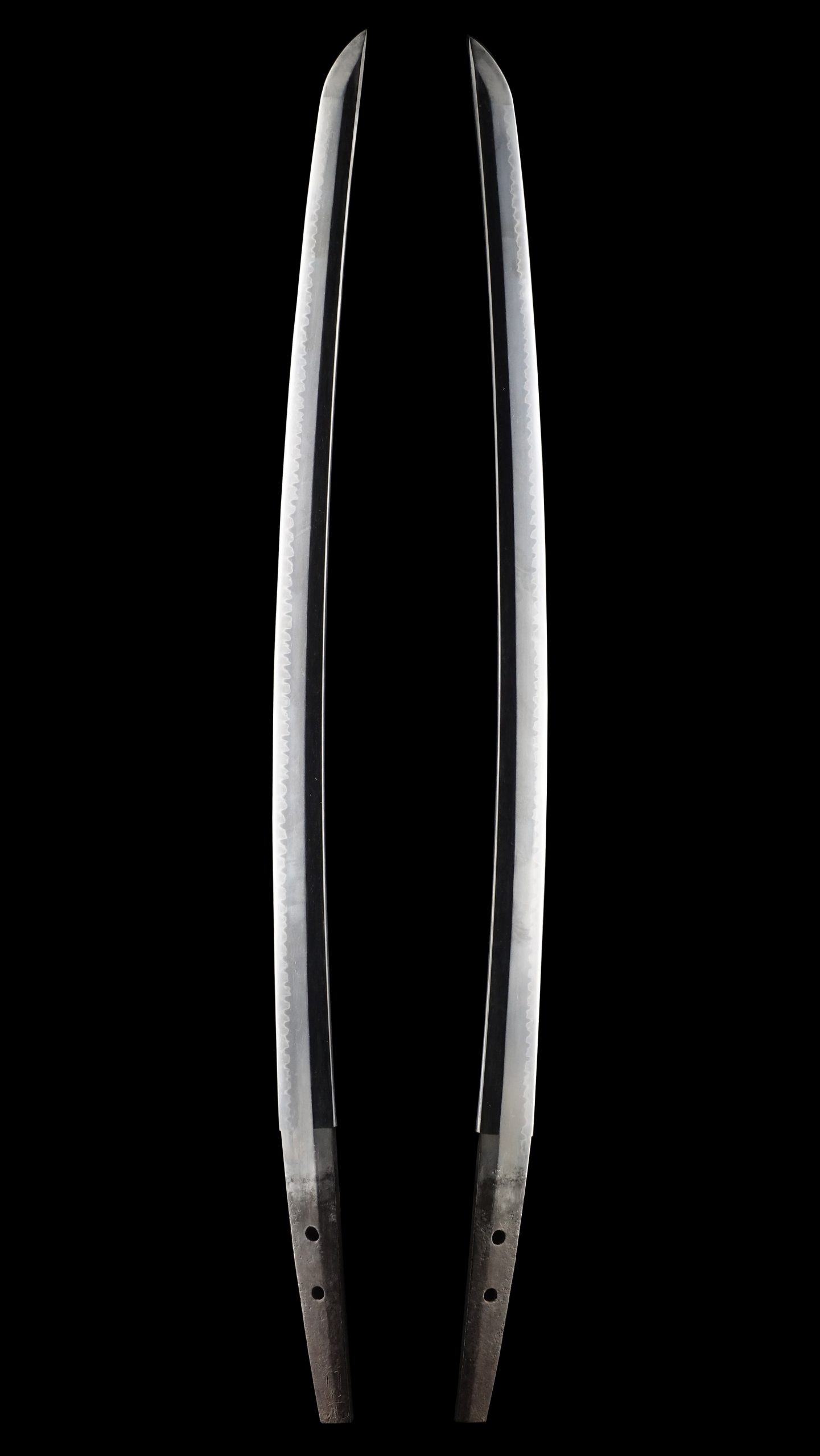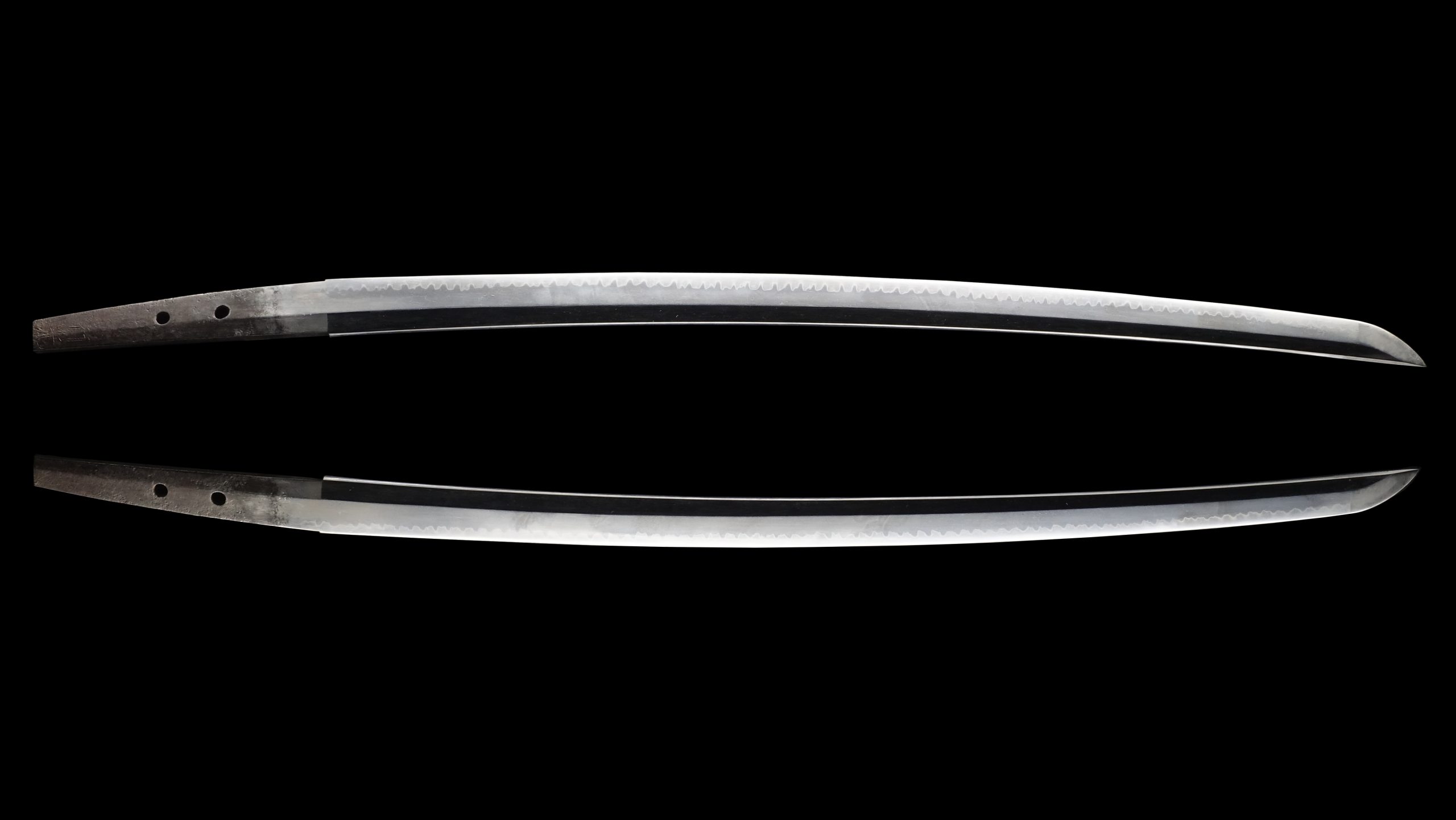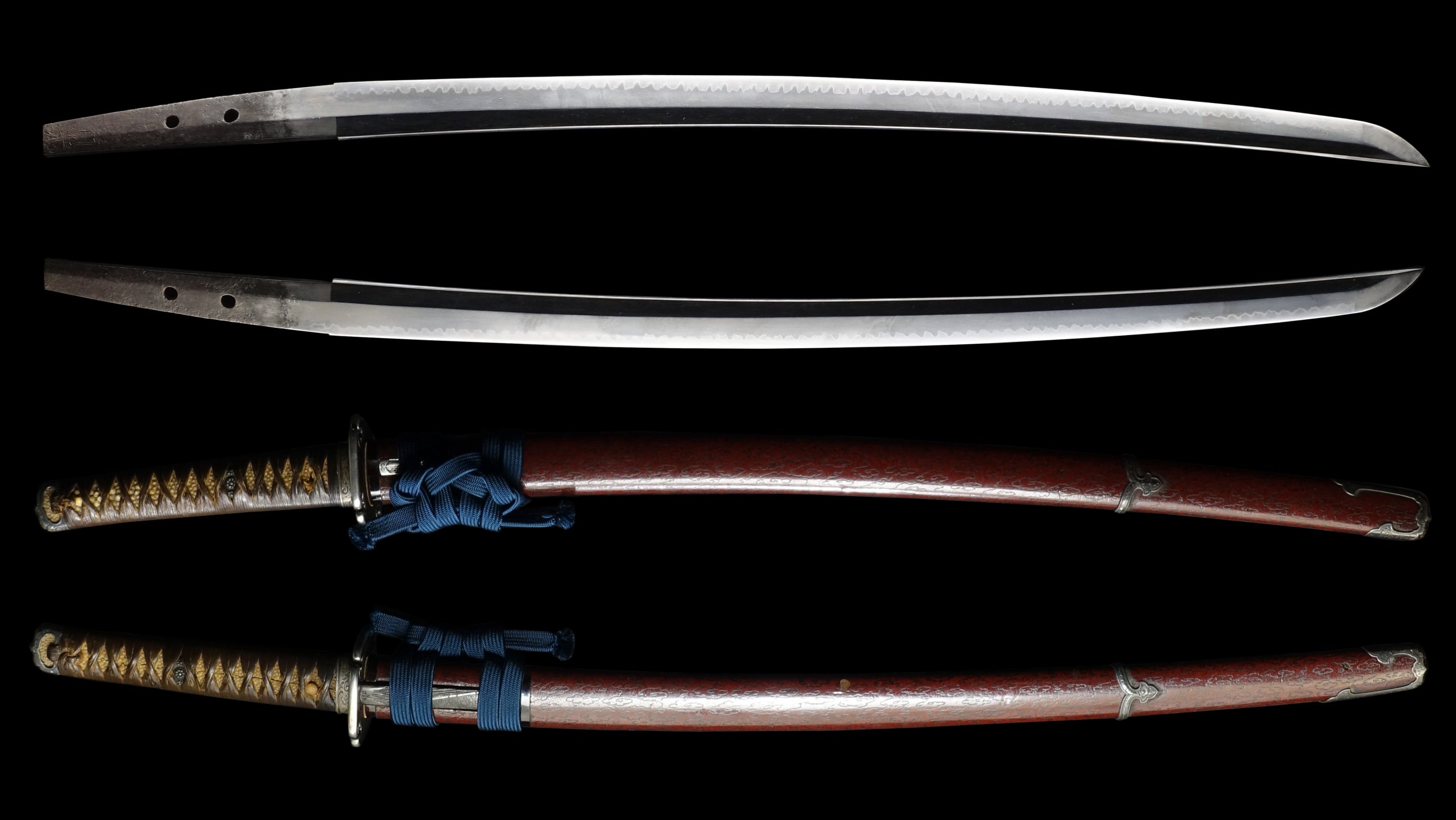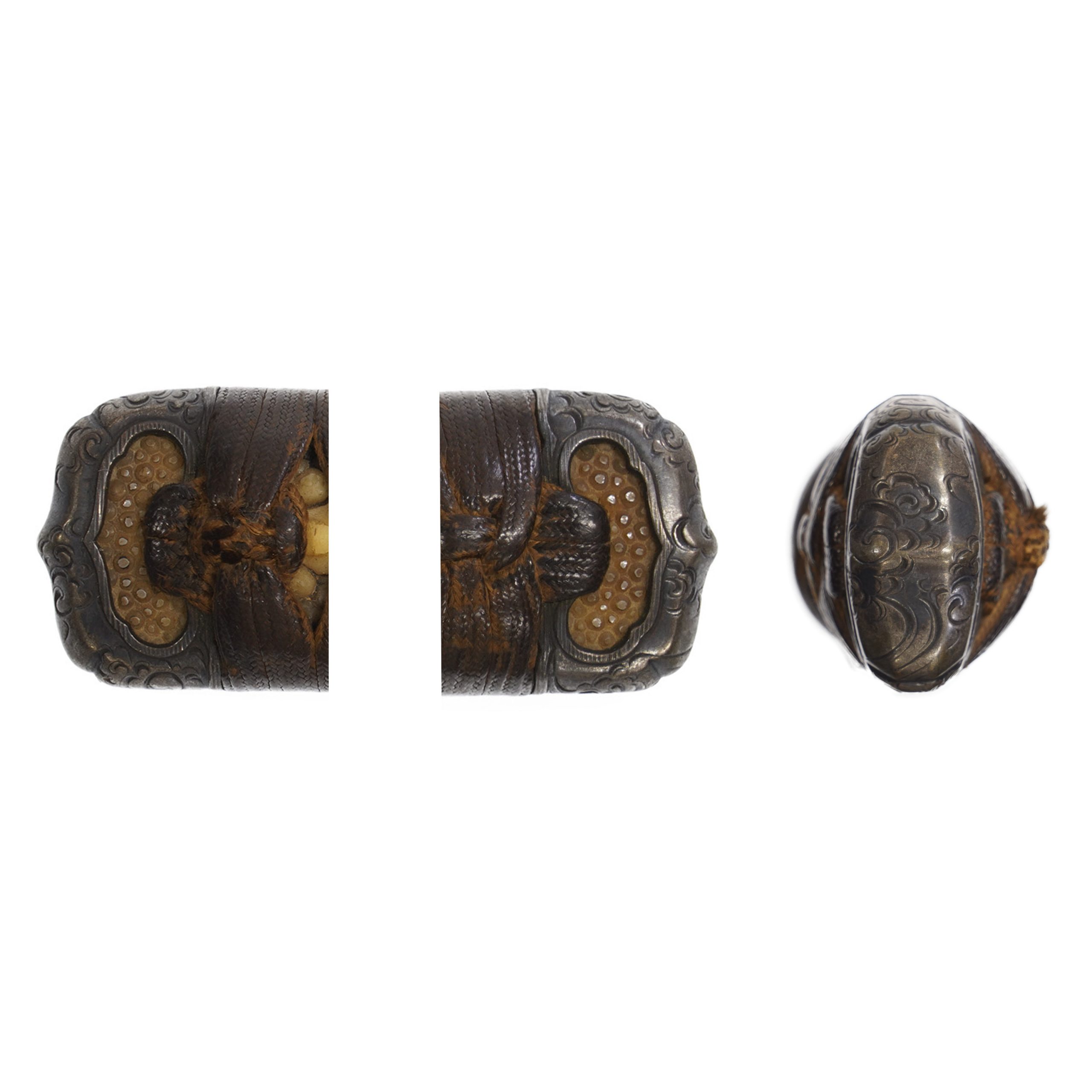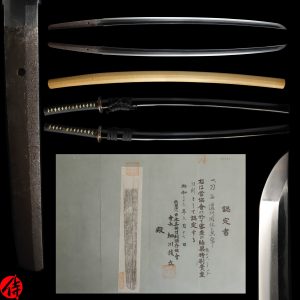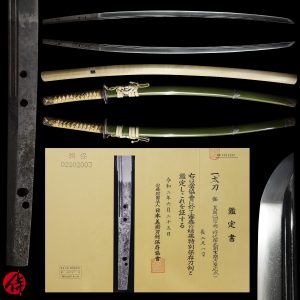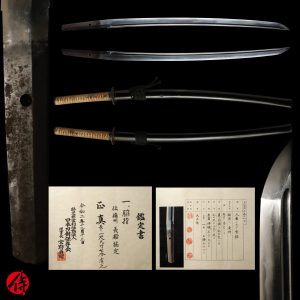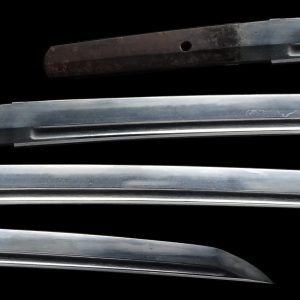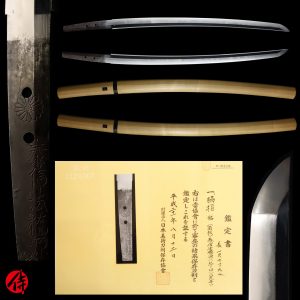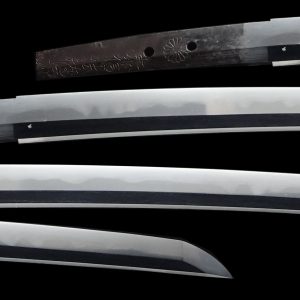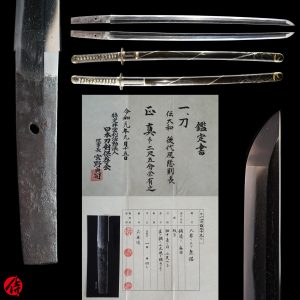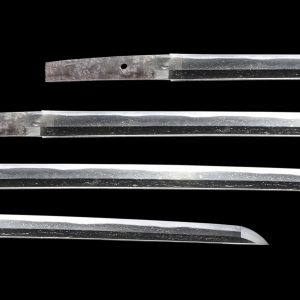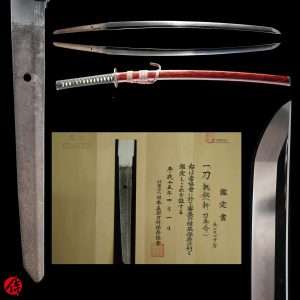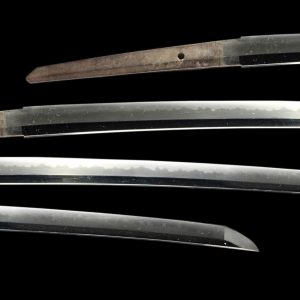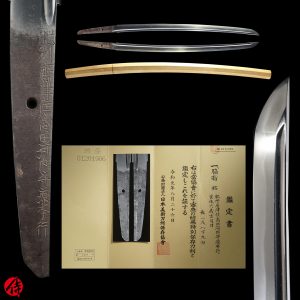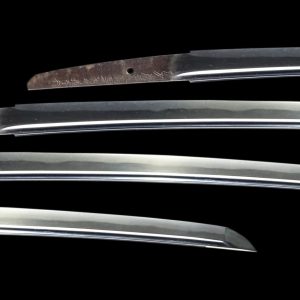Antique Japanese Sword Wakizashi Signed by Fujiwara Yukimitsu with NTHK Kanteisho Certificate
【Description】
According to NTHK that appraised this blade, it was forged by Bungo Takada Yukimitsu(豊後高田行光) during the Enpo era(Early Edo period: 1673-1681). Bungo is the name of the province in Ohita prefecture and Takada is the name of the school Yukimitsu belonged.
Takada school was founded by Takada Tomoyuki in Takada village, Ohita prefecture, during the Nanbokucho period. (1334-1338 A.D). Tomoyuki went to Bizen province(today’s Okayama prefecture) to master the sword-forging techniques of BIZEN and came back to the village and trained his apprentices. That is how Takada school started.
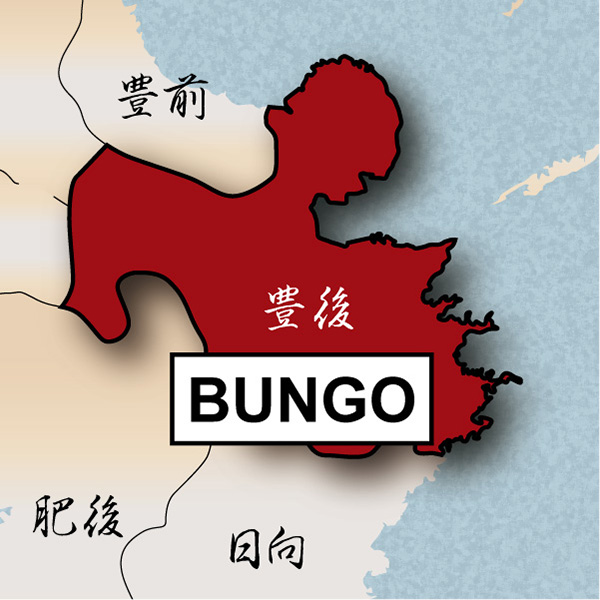
Those who forged swords in Takada village before the Edo period are called Taira Takada and Fujiwara Takada during the Edo period. Based on the authentication paper, this blade is categorized as Fujiwara Takada. Fujiwara Yukimitsu also forged swords in Kumamoto prefecture.
During Sengoku Period(the warring state period: from late 15 C to late 16 C), the Takada school forged many swords for feudal lords in Kyushu island. It is said that the reputation of the blades forged by Takada school was close to MINO or BIZEN swords, two of which are the most famous sword forging places. This highly skilled sword forging technique was passed down to later generations in the Edo period.
Generally speaking, Kyushu island was prosperous in sword-making because of the long history of trading with Asian countries. To gain an advantage in trading, many feudal lords on this island fought against each other. Takada school was able to receive many orders as the demand increased among those lords.
The material of Japanese swords(high-quality iron sand and charcoal) was abundant in the mount Sobo Katamuki, located near Takada village. We believe Takada school prospered because of its geographic location and natural resources.
The sword mountings of this blade were also appraised as antique made in the mid-Edo period. This kind of sword mounting is called Han-dachi Koshirae(Half- Tachi style sword mounting).
【 Blade】
Cutting Edge Length(Nagasa):53.0 cm ( 20.86 inches)
Curvature(Sori):1.2 cm( 0.47 inches)

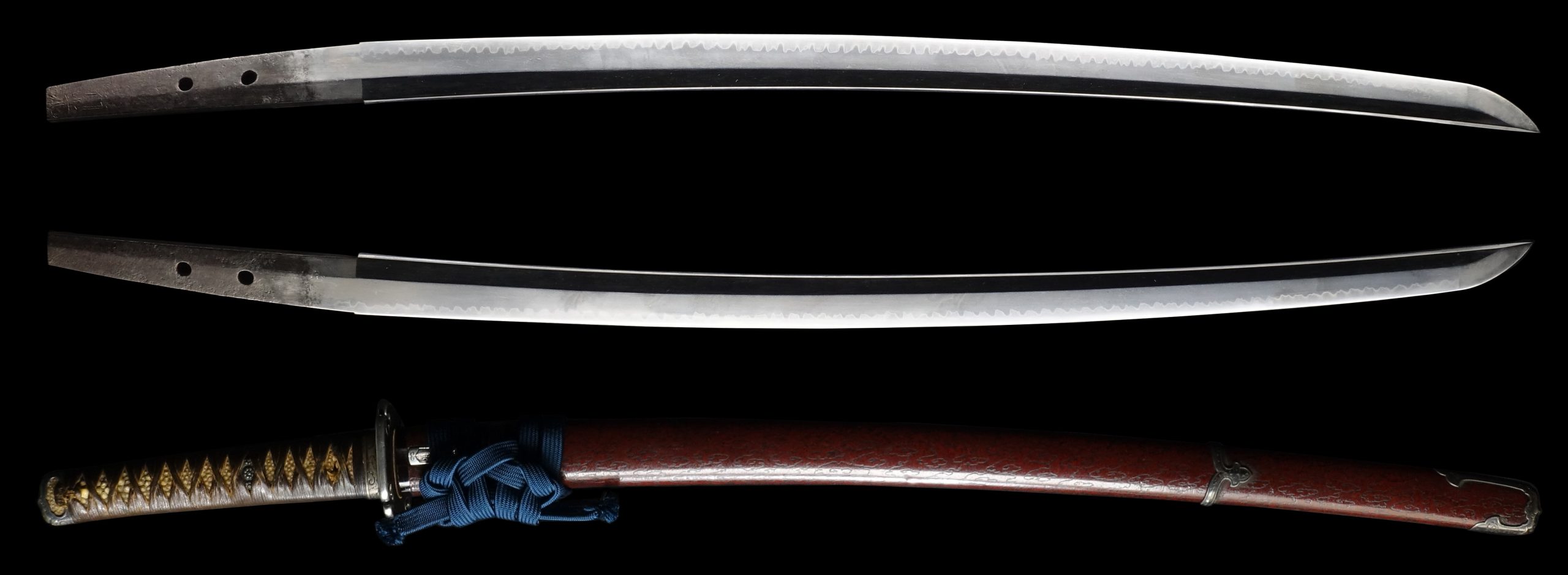
Hamon:
The crystalline structure which forms along the cutting edge of a blade as a result of the hardening process
Jimon:
visible steel surface pattern created by folding and hammering during forging process
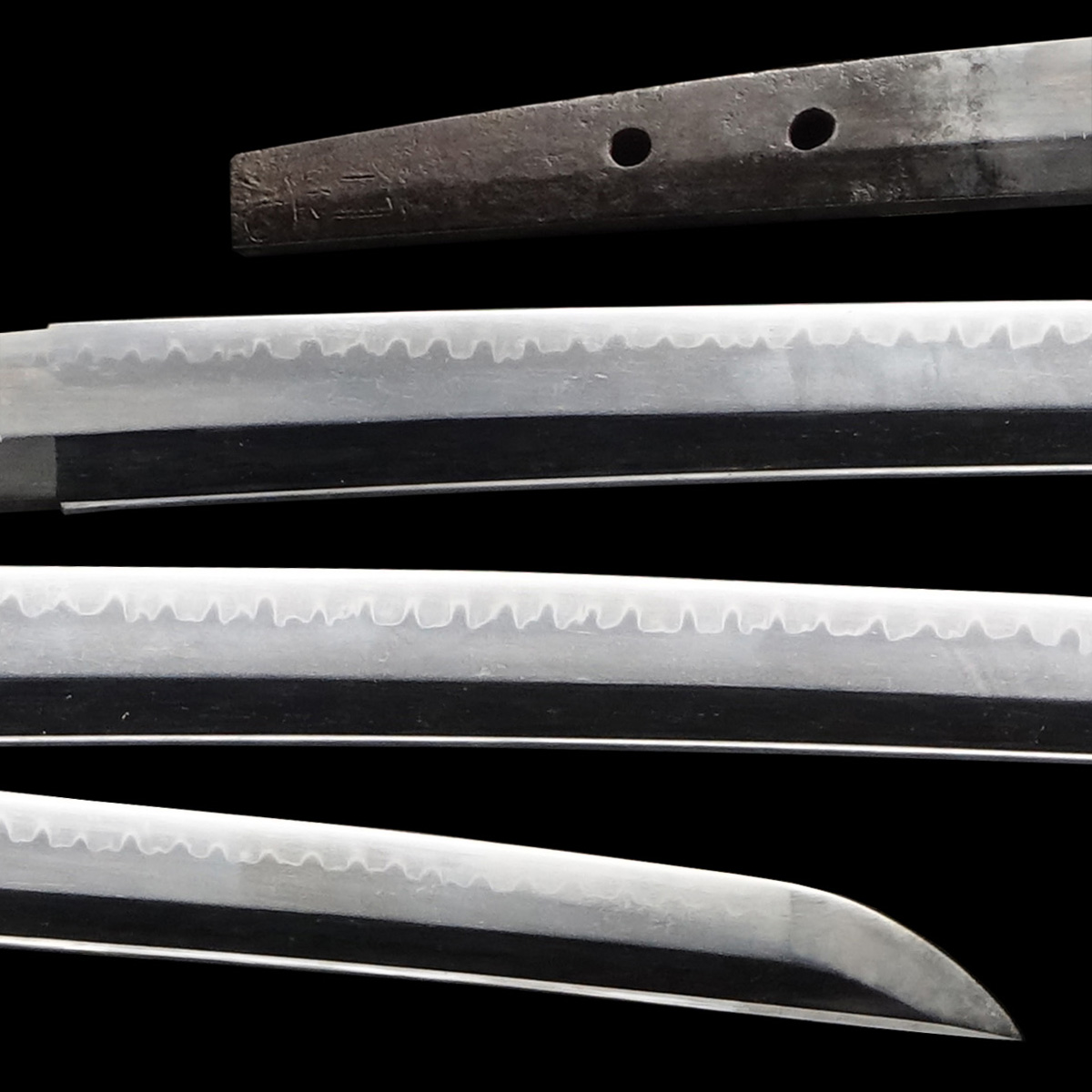
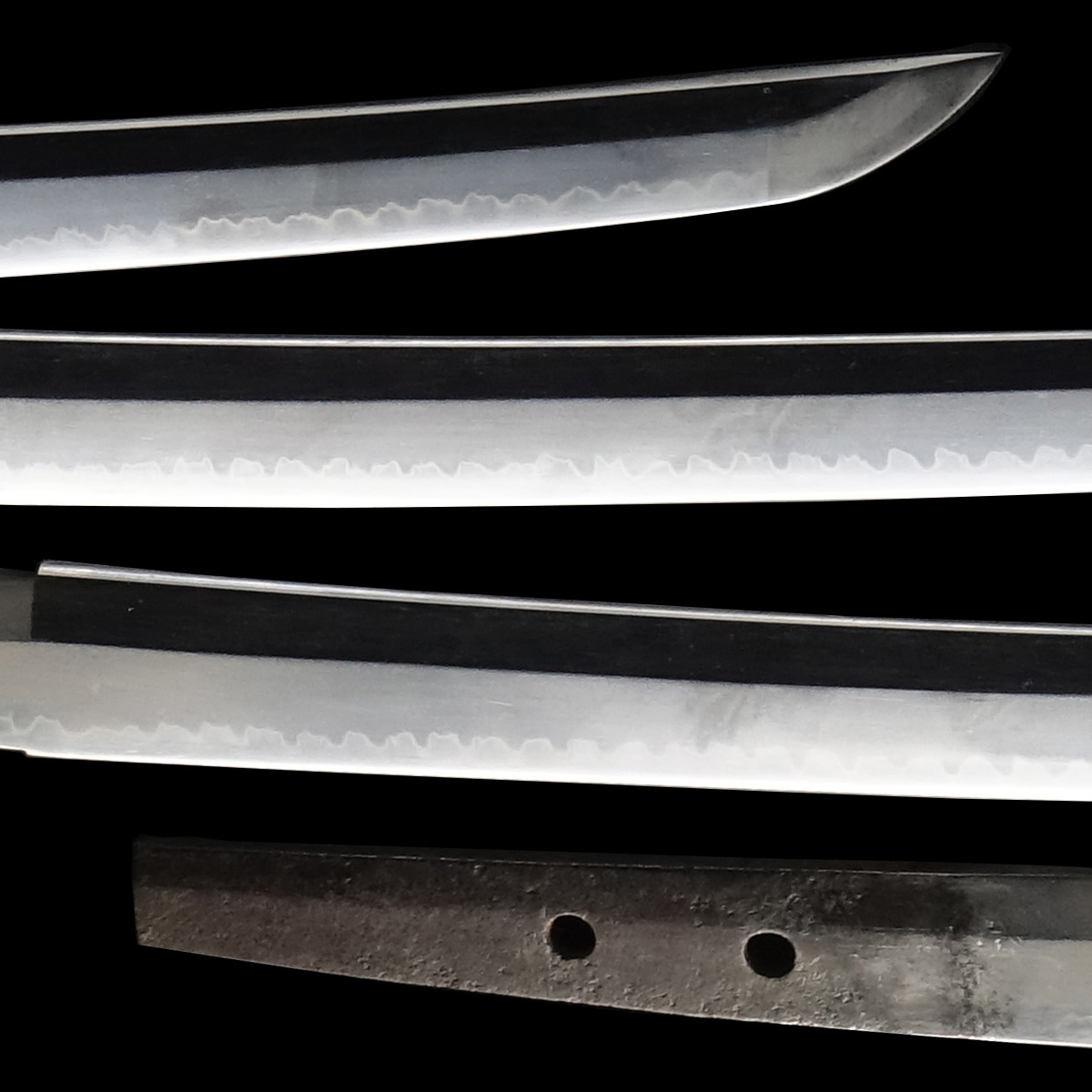
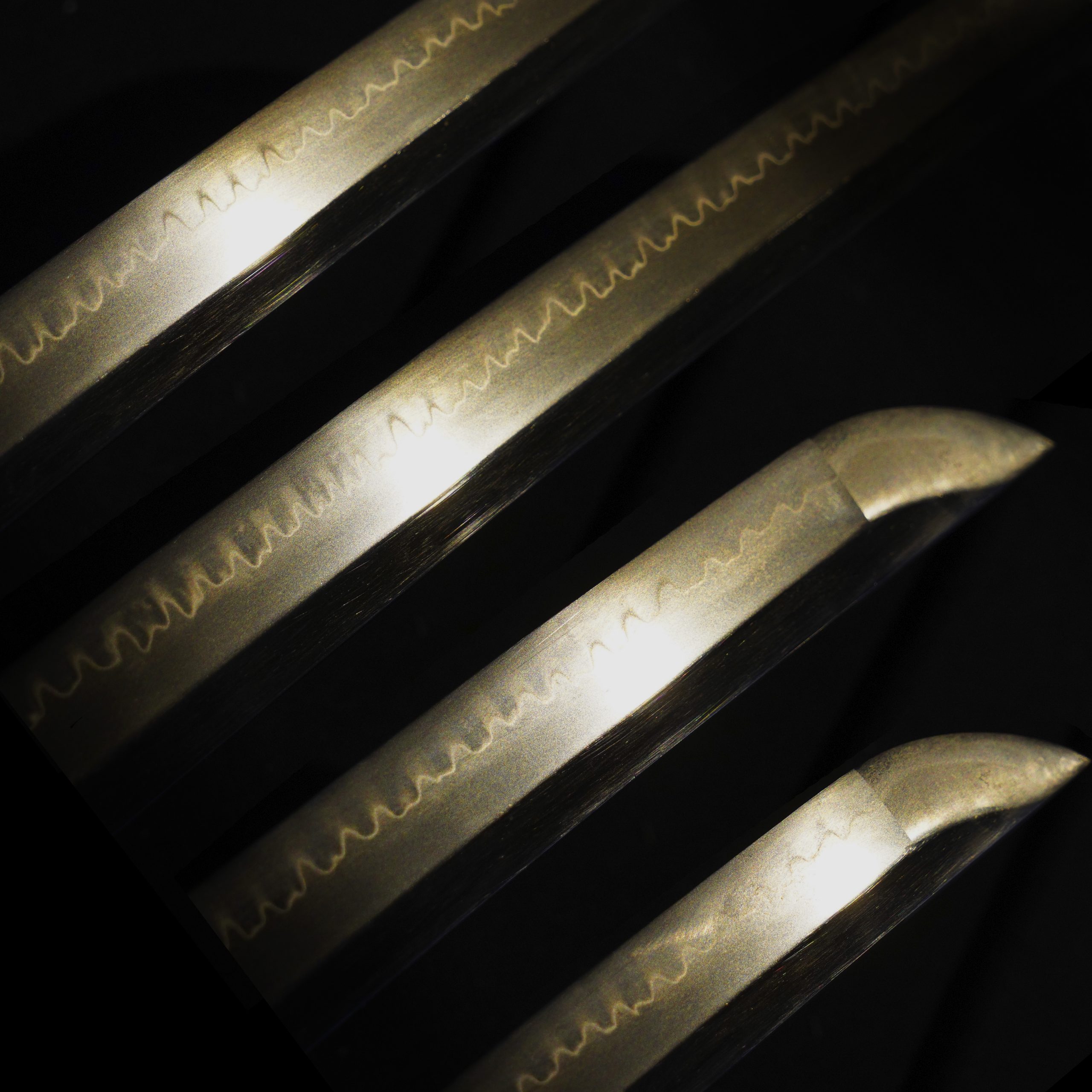
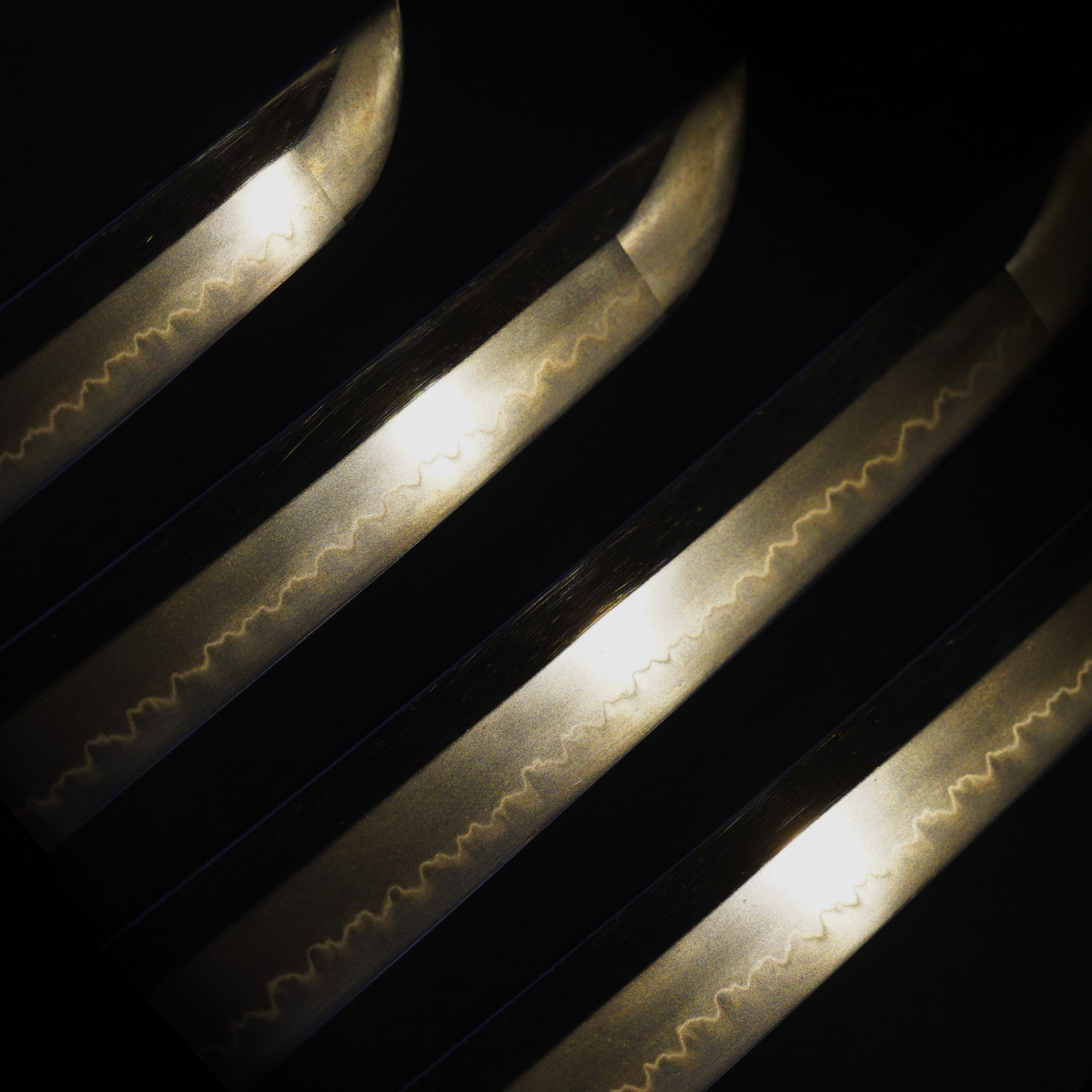
Nakago:Nakago is the tang of the Japanese sword.
Japanese swordsmiths left the black rust on the tang on purpose to prevent red rust while the tang is in its handle. And the discoloration of the tang was created over time, which is a great indicator for a Japanese sword specialist to estimate when the sword was forged.
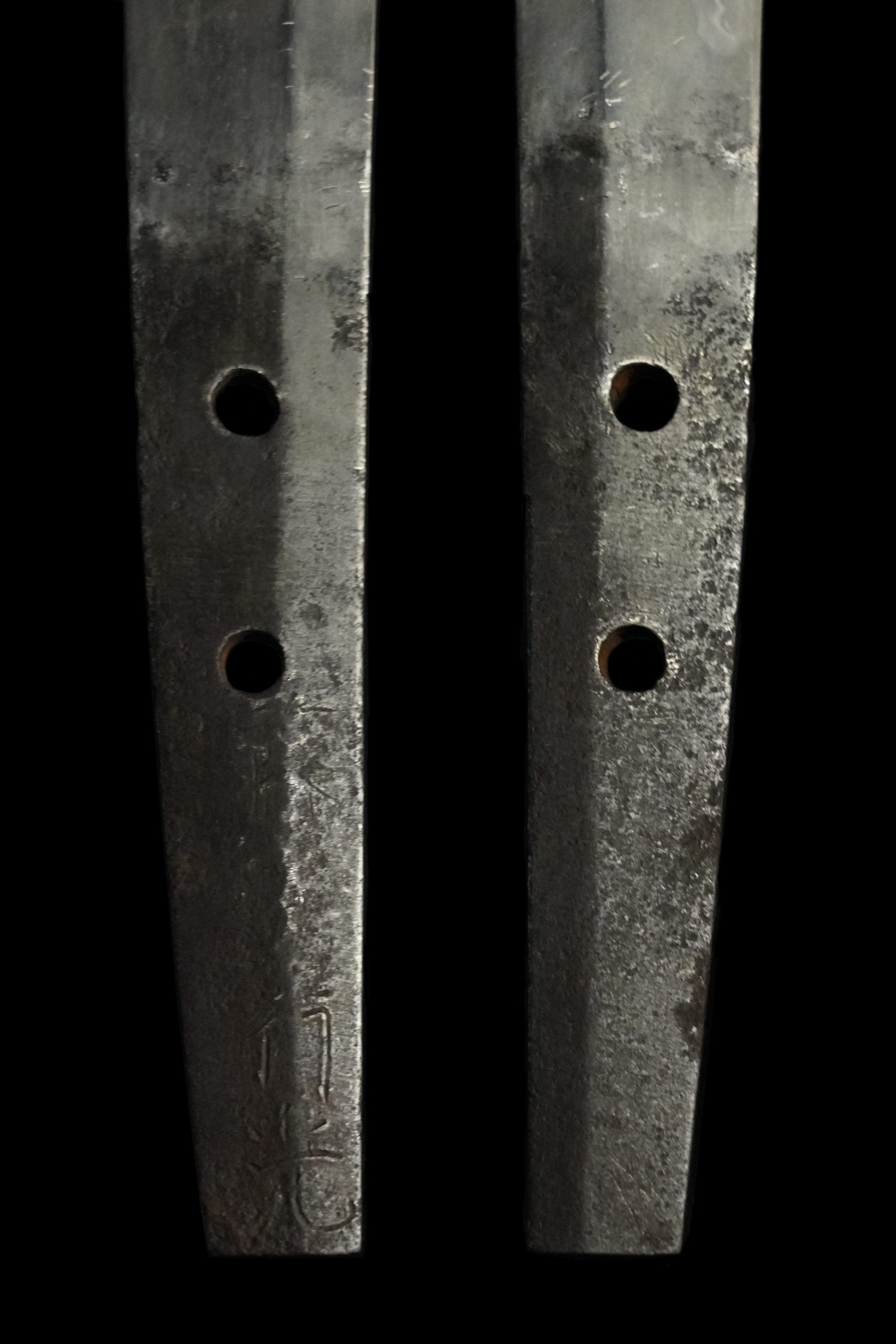
Koshirae: Koshirae is the mounting of the Japanese sword. There are several parts that consist of Koshirae such as Saya(Scabbard), Tsuka( Handle), Tsuba(Handguard).

Fuchi-Kashira:A pair of matching sword fittings that cover the upper and bottom parts of its sword hilt.
The cloud pattern is designed for the entire this Fuchi Kashira. According to a theory, gods and dragons dwell in clouds. And clouds bring rain. So that people regarded the cloud as sacred existence and believed that it has magical power. Also, since clouds constantly change their shape, people once told one’s fortune from clouds’ forms. The cloud is rooted in people’s daily life as a familiar existence. Therefore, it is understandable that this motif is appreciated as a design for various items since ancient times. For sword mountings, we often found the combination of clouds and dragons. The dragon god-belief is possibly related to this design. In this faith, people worship a dragon as a water god. Its noble and majestic appearance might be one reason why Samurais loved to apply this pattern to their swords.
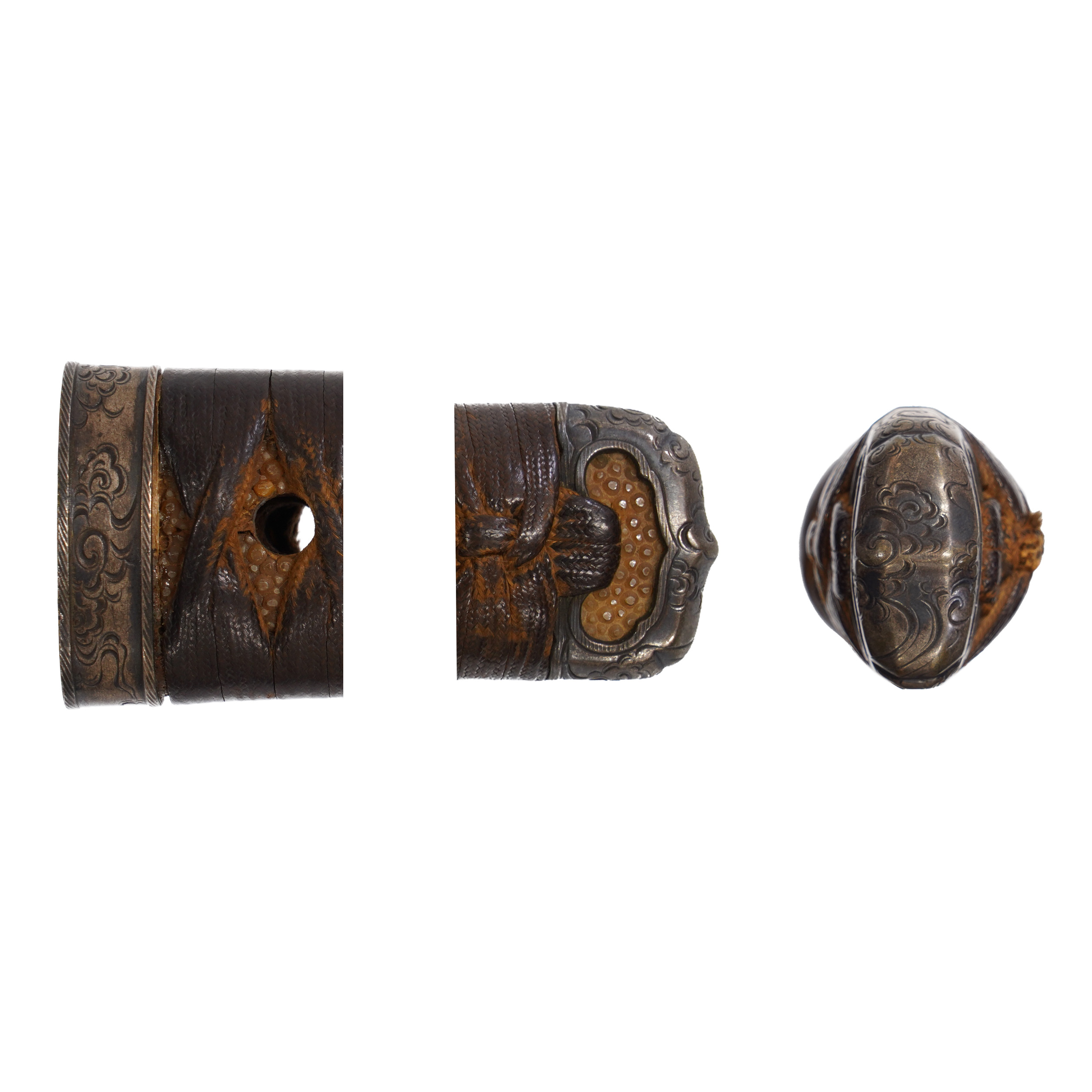
Tsuka and Menuki:Tsuka is the handle of the Japanese sword and Menuki is its decoration.
It is probably a kind of flower that is designed for this Menuki. It is challenging to judge what variety plant; however, it seems each flower has eight petals. The silvery metal is applied to each tiny dot and makes a contrast between its silver color and the color of this Menuki’s principal material (might be copper). You would also enjoy its symmetrical design.
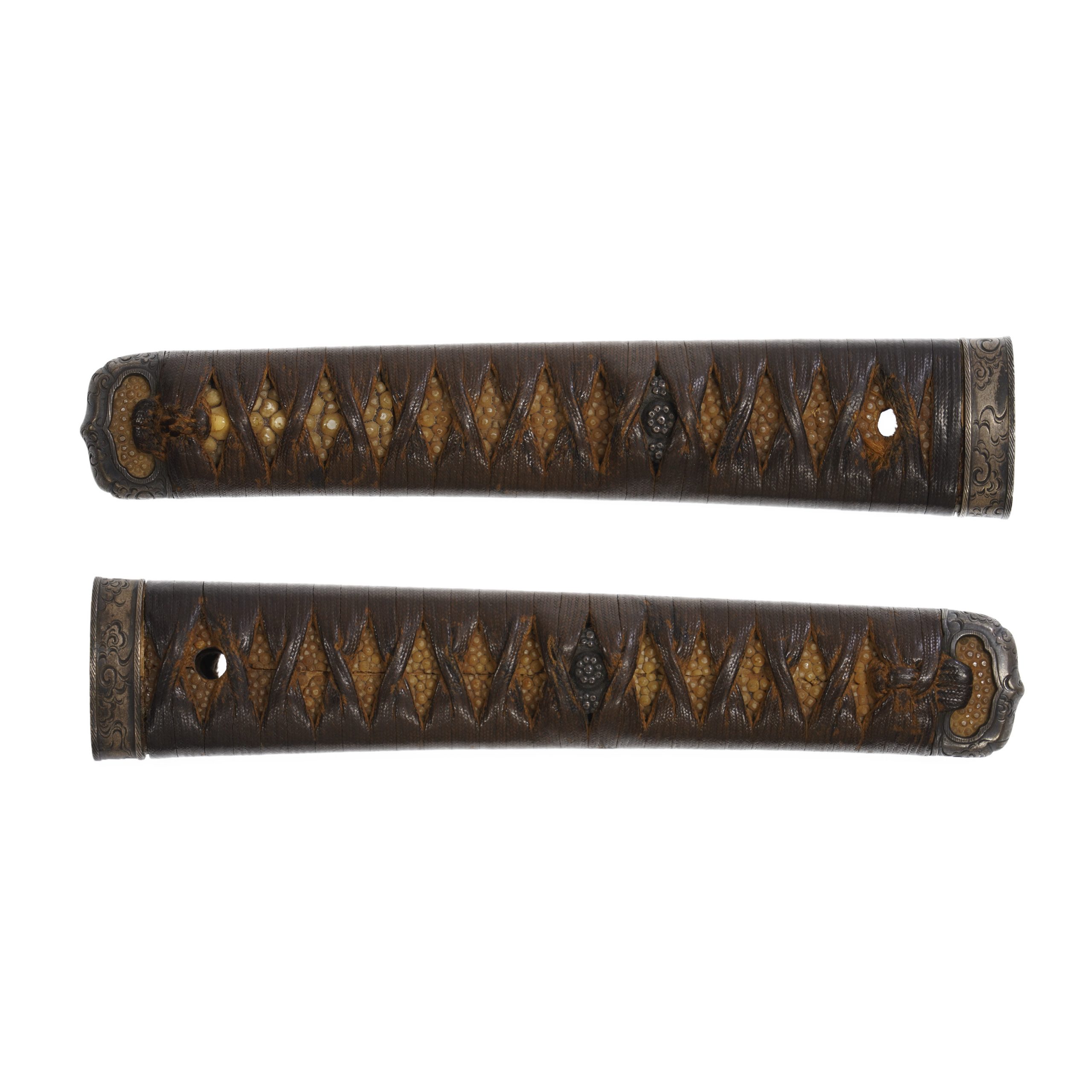
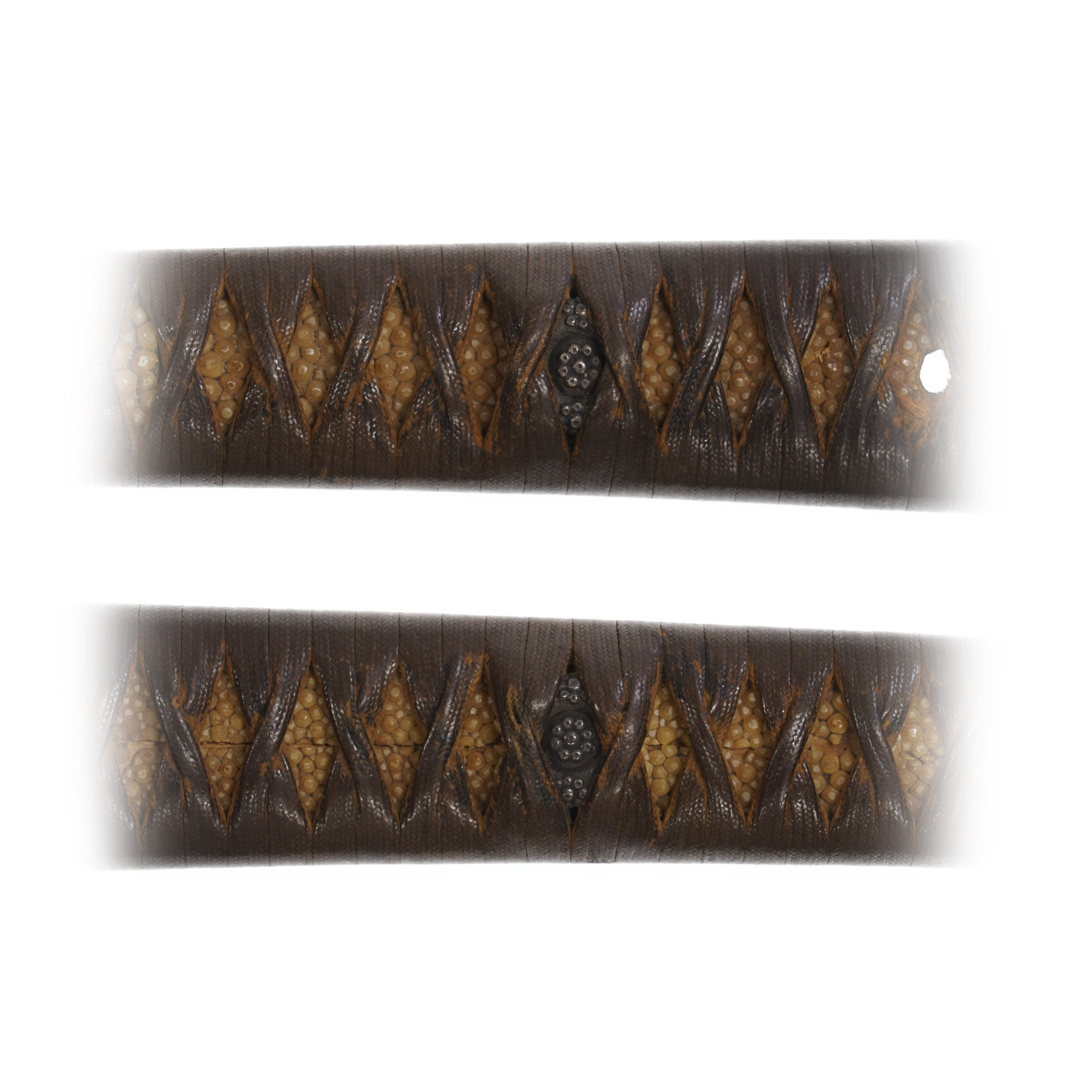
Tsuba and Habaki:Tsuba is the handguard for the Japanese Sword and Habaki is the equipment to make the blade not touch its scabbard inside. It prevents the blade from getting rusty and chipped.
This Tsuba has Aoi (葵) shape and is made from iron. Its Mimi (耳, edge of Tsuba) is covered with silver; it gives a shiny look for this work. This decorative technique is used to provide the Tsuba a gorgeous beauty. It also has practicality, such as preventing the wear of the edge part. Also, it prevents the wear and tear of the Kimono if the edge damages it by touching the cloth.
If you focus on four corners of this Tsuba, you will find hear mark-shaped carving. It is called Inome Mon (猪の目文), Inome means boar’s eyes in Japanese. The Inome pattern has been used since ancient times. Some people believed that the Inome design works as an amulet to protect us from evil spirits or fire. Also, it is said it would bring good luck. This pattern is often found in traditional Japanese architectures such as shrines or temples and used Gegyo (懸魚, decoration under the roof, where the roof is jointed) or metal fittings for hiding timber joints.
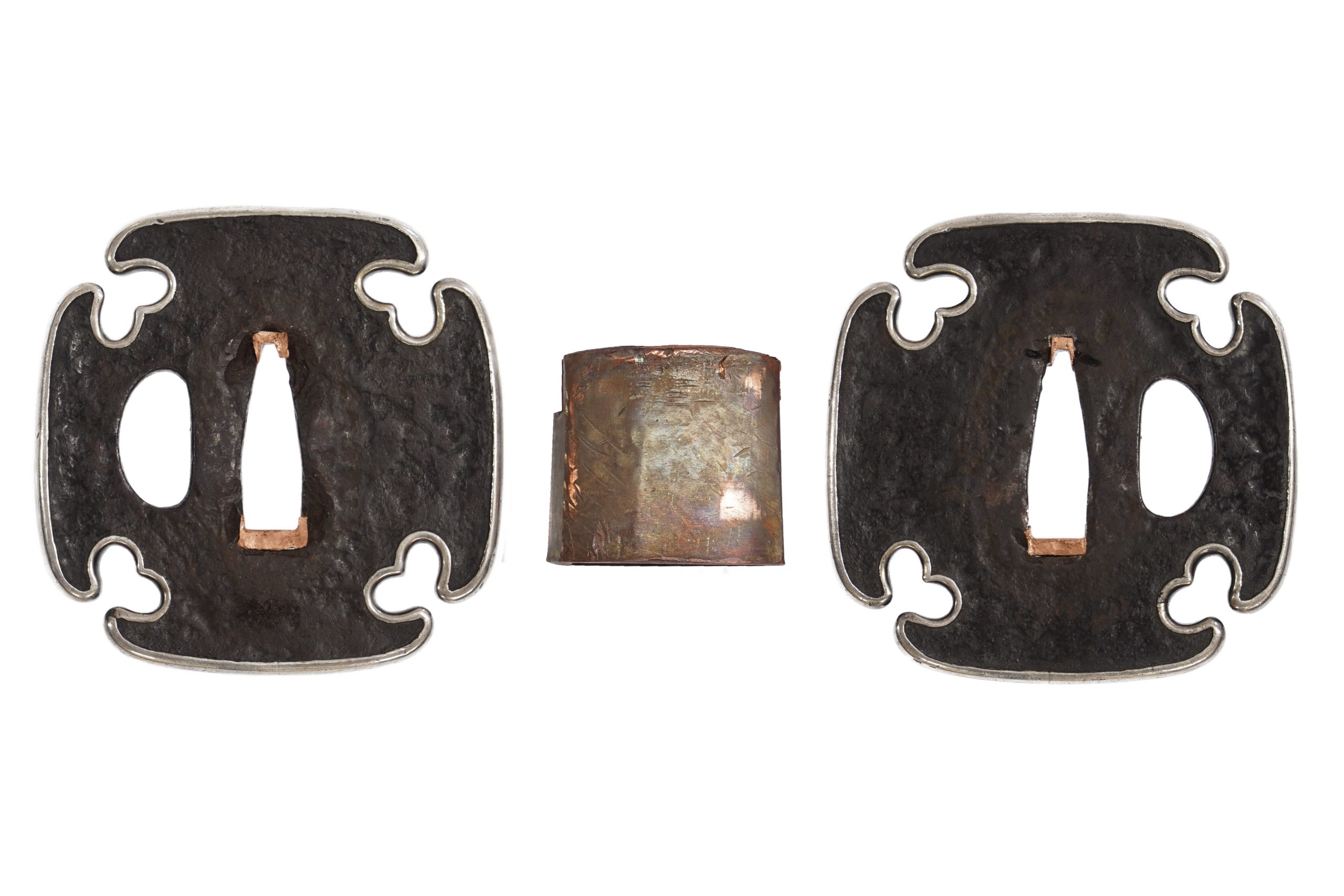
Saya: Saya is the scabbard for the Japanese sword.

Kozuka:Kozuka is a small knife stored in Kozuka Hitsu(groove of the sheath of the Japanese sword).
An elongated rod is carved. As its background seems the surface of the sea or river, this stick might be a fishing pole or a paddle. Since Japan is an island country, the blessings of the sea were a crucial food source. Because of the desire to pray for the safety of the voyage, such a motif might have been preferred. Or, Samurais might have wished they had the bravery of fishermen on dangerous journeys.
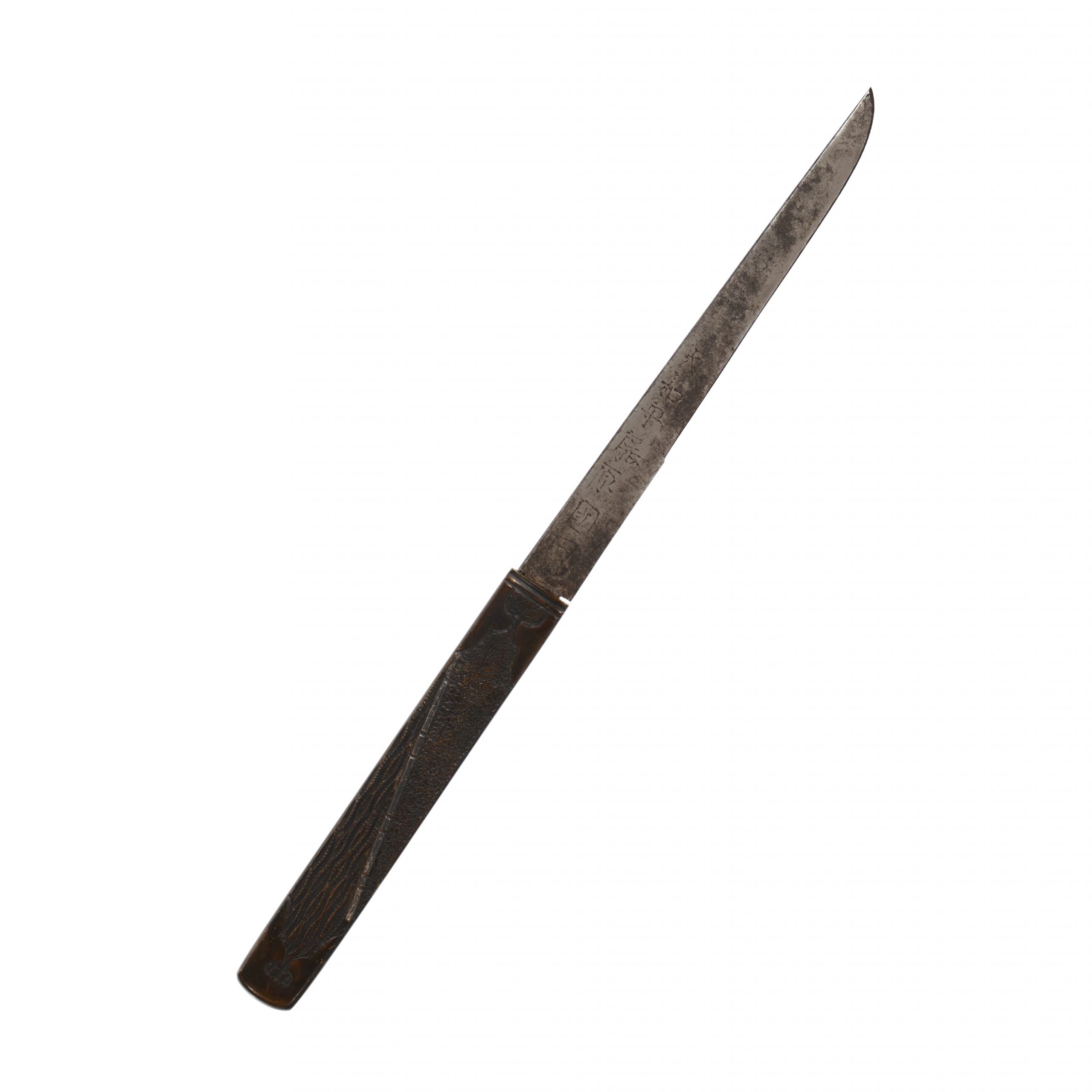
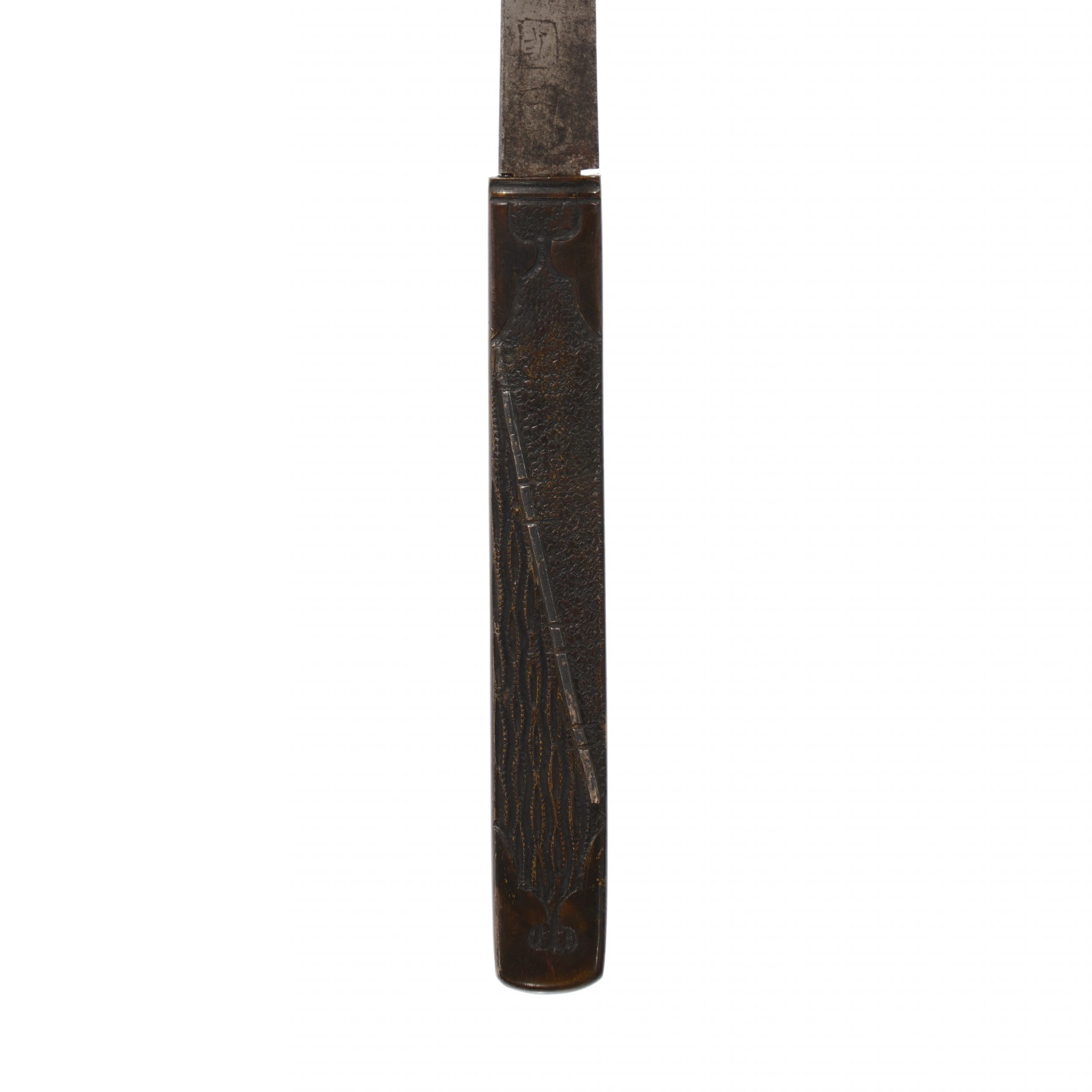
Authentication Paper:NTHK Kanteisho Certificate for the blade
NTHK, also known as Nihon Touken Hozon Kai (the Society for the Preservation of the Japanese Sword), is one of the oldest Japanese sword appraising organizations in modern-day Japan. They authenticated the blade and sword mounting(Koshirae) on April 18th in the third year of Reiwa(2021). They appraised them as the Kanteisho class, the blade worth preserving for Japanese society. The purchaser will receive this original certificate as well. We can also translate what is written into English and make a PDF file for your record if you request.
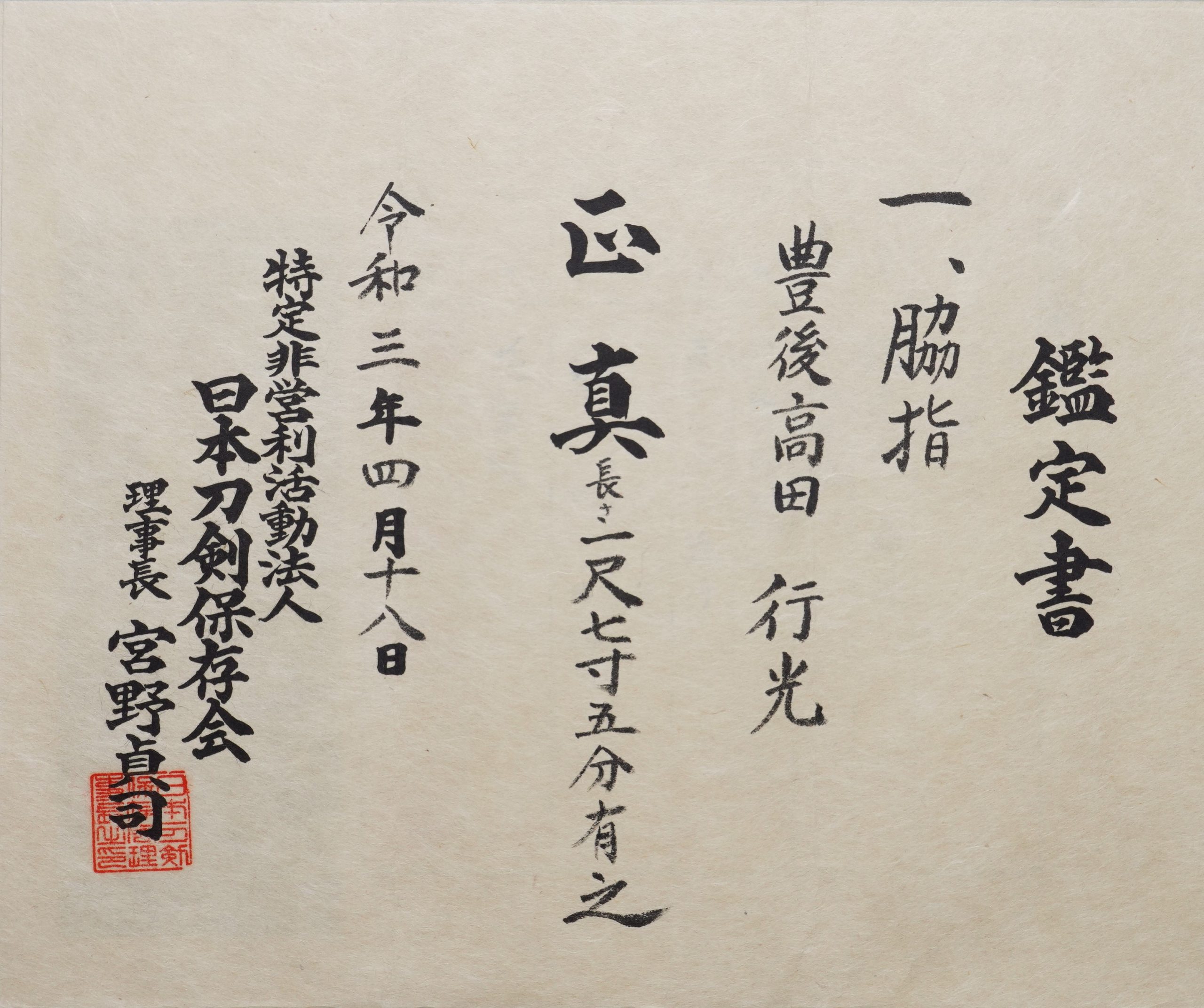
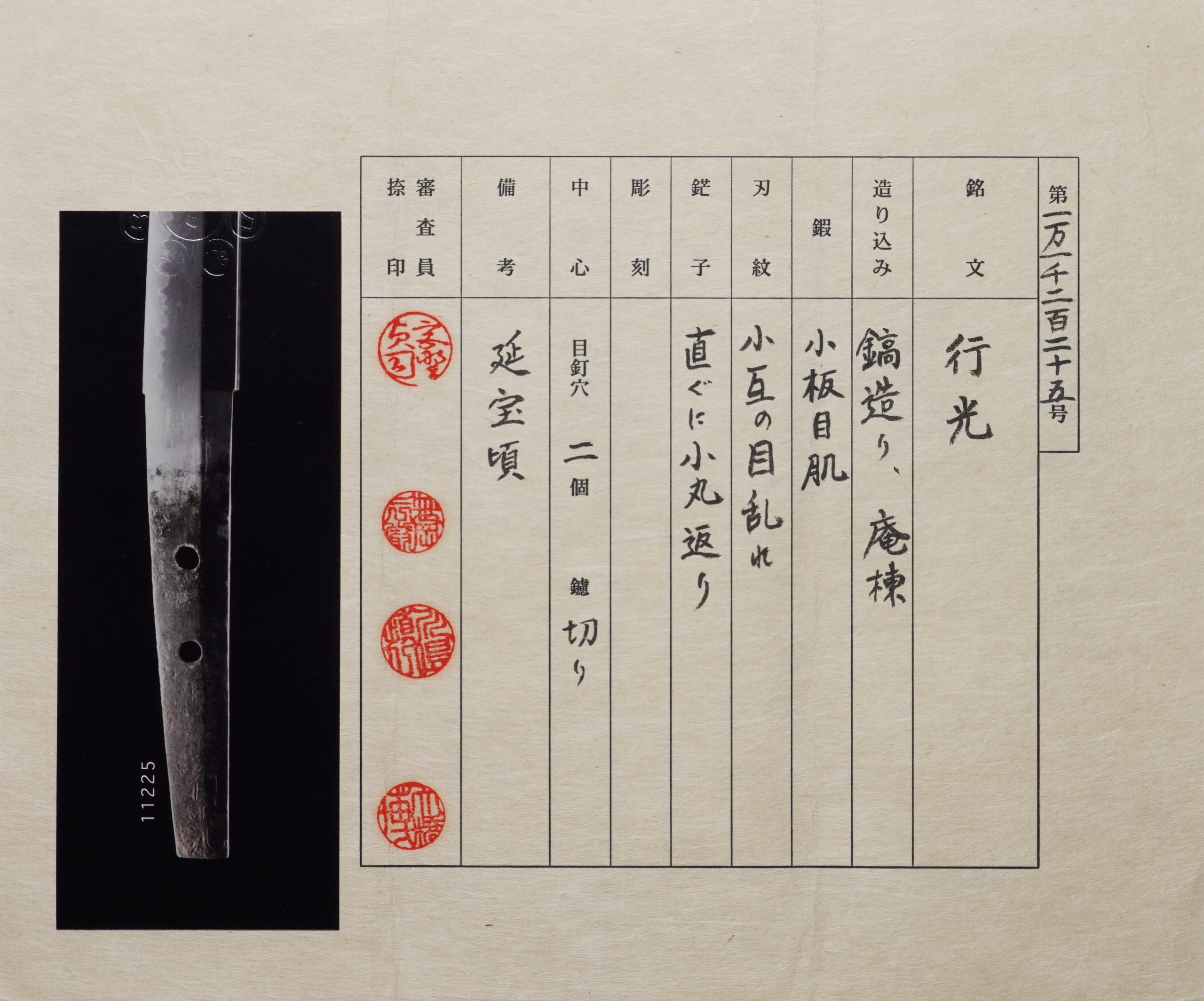
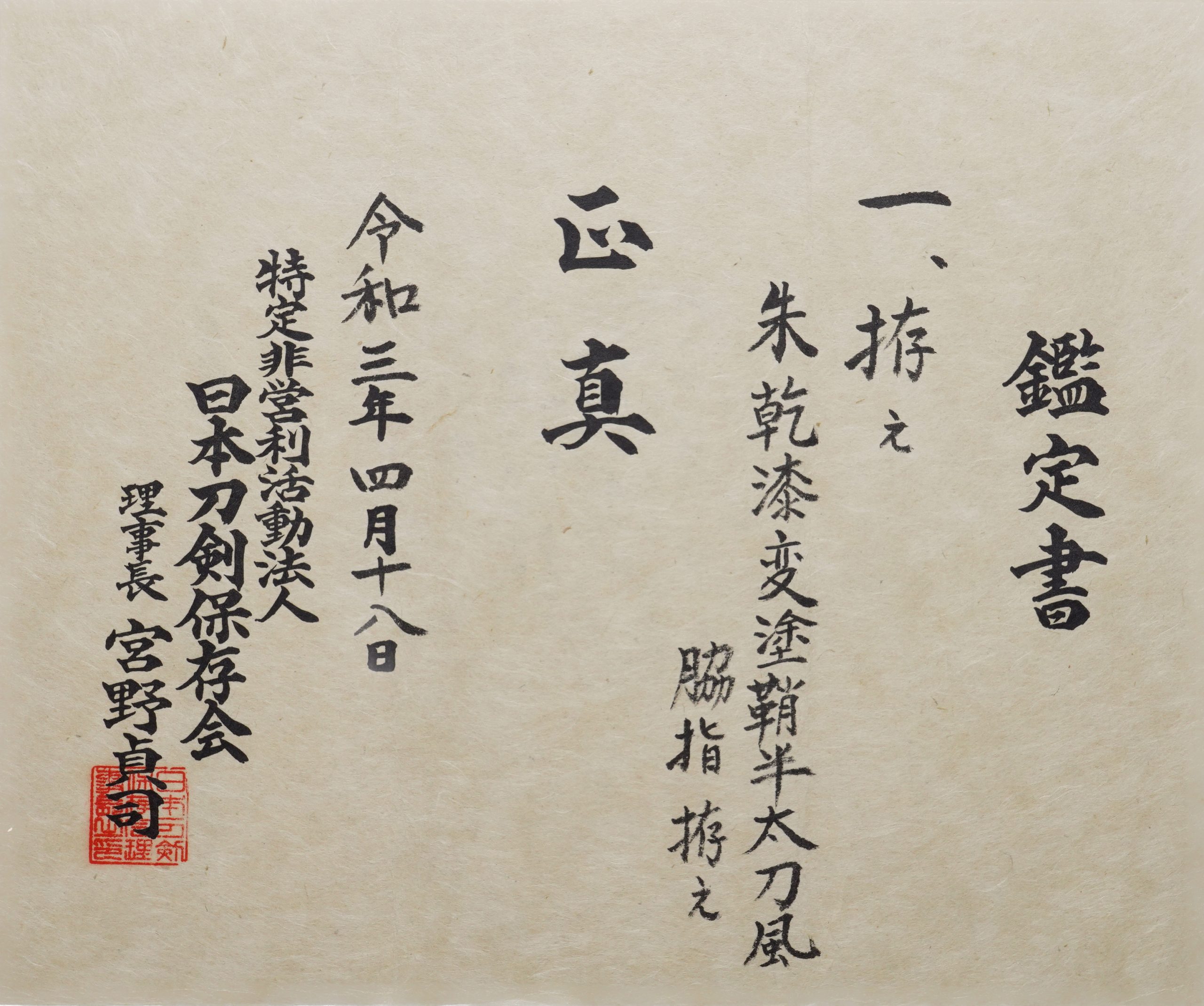
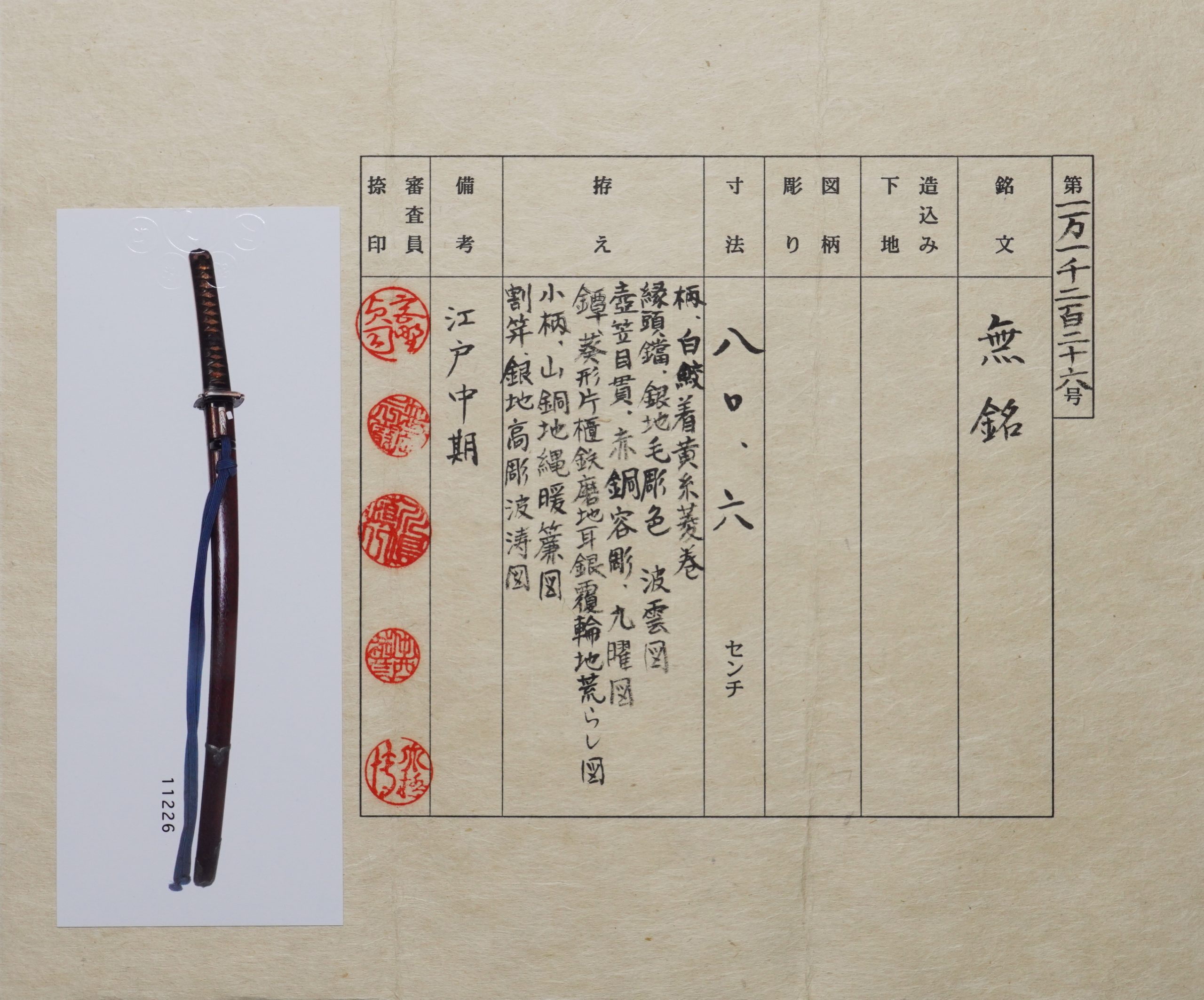
Registration Number : Kumamoto 52831
The Board of Education in Kumamoto prefecture issued a registration paper for this sword . In order to obtain this paper, the sword needs to be traditionally hand forged. With this paper, its owner can legally own an authentic Japanese sword in Japan. This paper will need to be returned to the board of education when the sword being shipped abroad but you can receive a copy of it.
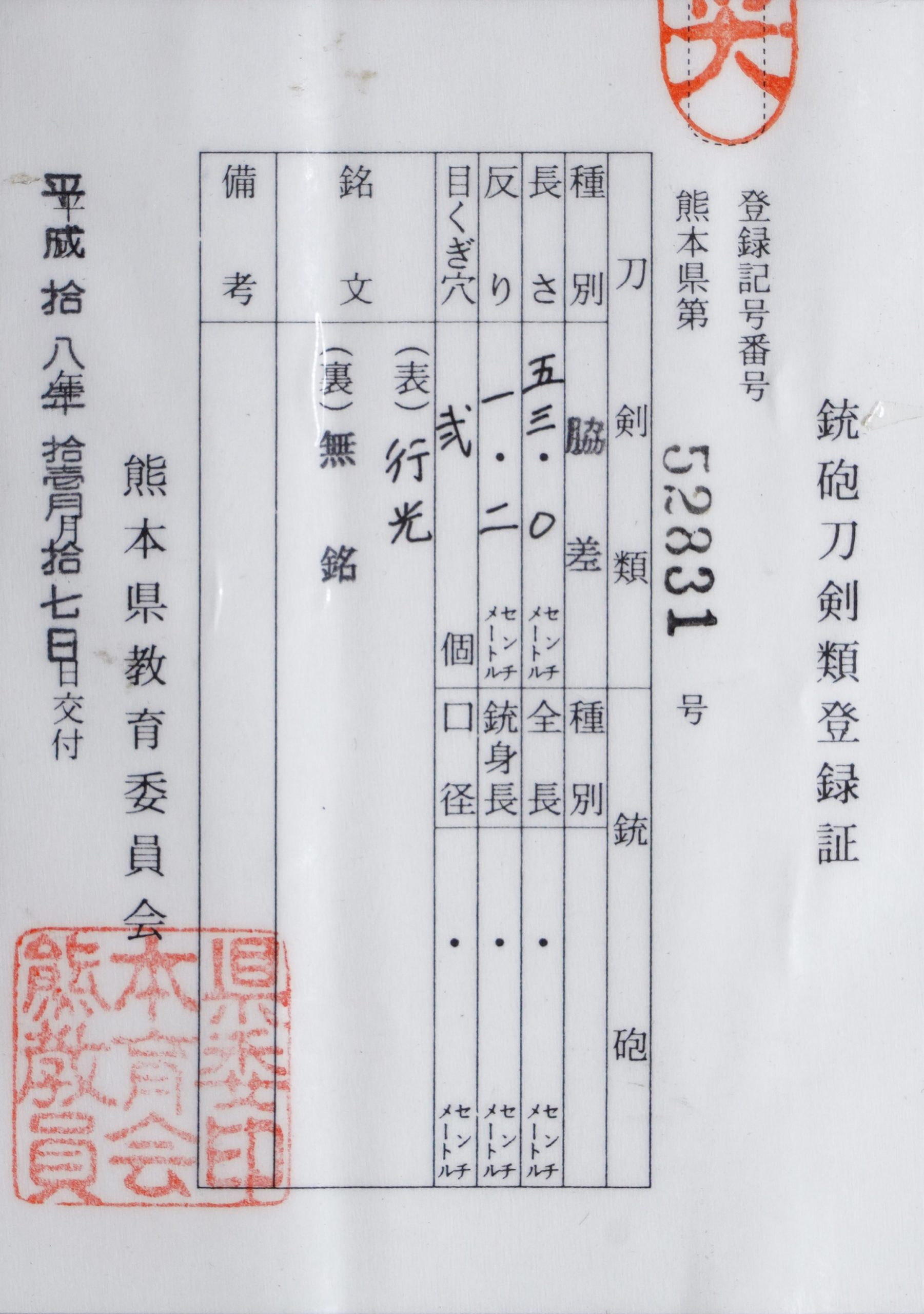
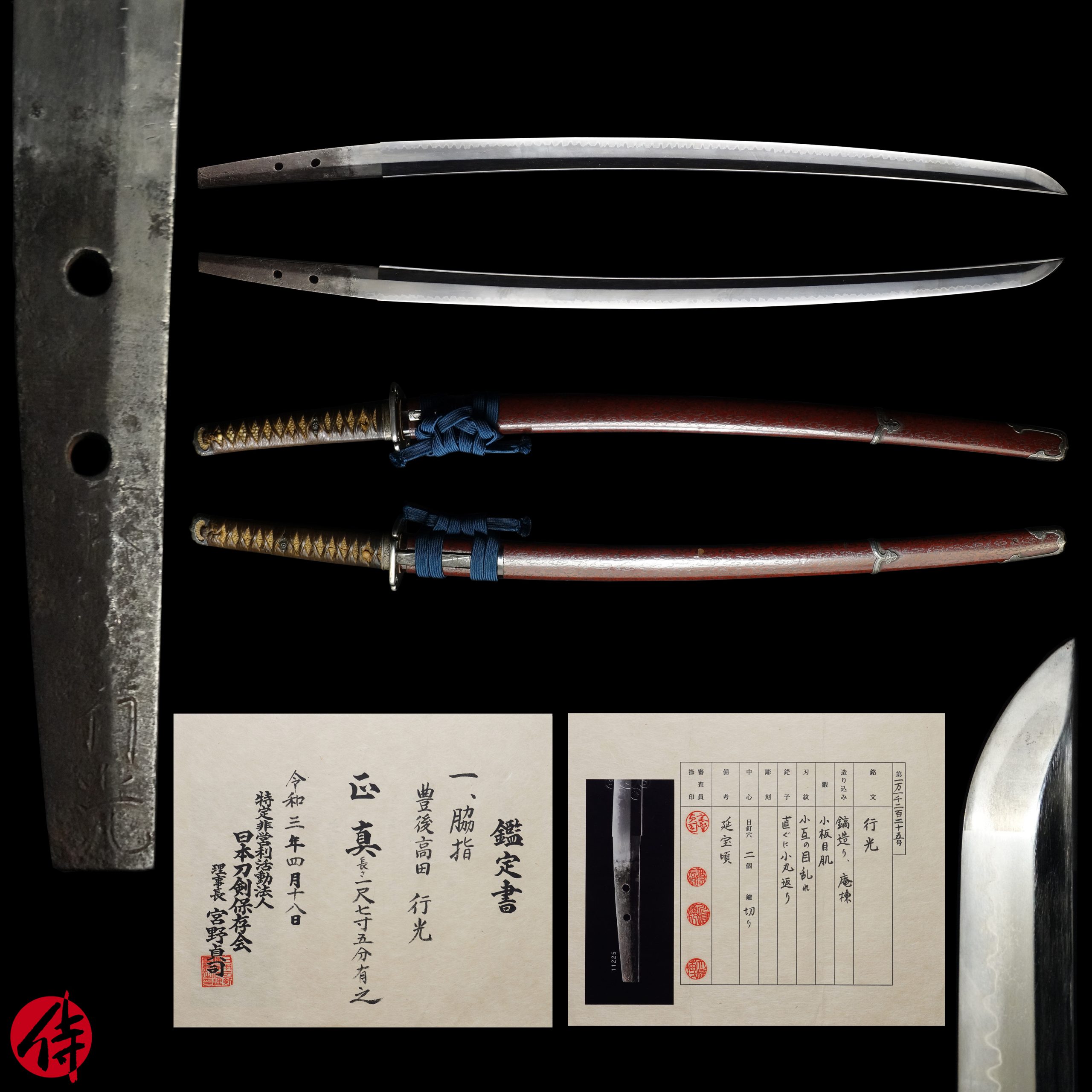
—————————————————————–
【About us】
Samurai Museum is located in Tokyo, Japan, exhibiting antique artifacts related to the Samurai history. Samurai Museum Shop is the place for those who are interested in Japanese culture and craftsmanship. We deal with antique Samurai swords/armor, traditional crafts made in Japan and so on.
【Japanese Sword& Export Process】
The Japanese swords we deal with are hand-forged edged swords made in Japan. It was made from the traditional carbon steel called TAMAHAGANE(玉鋼). Samurai Museum is familiar with the proper legal procedure for an antique/ authentic Japanese sword to be exported from Japan. We have sent more than 300 Japanese swords to amazing owners who appreciate its historical value.
Each Japanese sword is registered under the Agency for Cultural Affairs and the Board of Education in Japan.They issue a registration paper for each Japanese sword for its owner in Japan to legally possess it. The Japanese sword with its registration paper means it was traditionally hand-forged in Japan.
To legally export the sword from Japan to other countries, we will have to apply for its permit to the Agency for Cultural Affairs(Bunkacho) and return the original registration paper to the Board of Education. It normally takes around 2-4 weeks to receive this permit after submitting required documents. And we would like you to expect at least 1-1.5 months for your order to arrive at your given address after you ordered. For more detailed info, please click here.
It is allowed for residents in Japan to own authentic Japanese swords without a special license as long as they come with registration papers. Please feel free to contact us if you are a resident of Japan, whether temporarily or permanently. We will also assist you when you leave Japan and need to obtain the export permit.
【Payment Method】
We accept payment through Stripe(Credit card), PayPal, Apple Pay or ChromePay, all of which are secure payment methods. If you prefer other payment method, please contact us. After confirming your payment, we will apply for an export permit. You may either pay in JPY, USD, AUD, EUR or GBP. The price is set in Japanese Yen. Prices in other currencies are automatically calculated based on the latest exchange rate.

【Shipping】
We have shipped authentic Japanese swords to the USA, Canada, Mexico, UK, Germany , France and Hong Kong. If you don’t live in these countries and like to order, please contact us first before making a purchase. We offer Free International Shipping as long as we can send antique Japanese swords by either EMS or FedEx(Canada).
We normally ship by EMS(Express Mail Service) provided by Japan Post. When we receive an order from the Canada we will use FedEx instead as EMS temporarily stops shipping from Japan to those countries due to COVID-19.
We will send you a tracking number for your order as soon as we hand it to the post office/FedEx. We will put 100 % insurance on the shipping document without any extra charge. Based on the total amount, there might be a duty tax or other fee for you to pay, depending on the countries. We use package cushioning to protect the item and put it in a PVC pipe, which is one of the most secure packages because of its durability.
It will normally takes 5-14 days for the item to arrive at your given address after we dispatch it. Time of delivery is estimated as accurately as possible by the carrier but does not take into account any delays beyond our control such as by inclement weather, post office holiday seasons.
*Please keep in mind that due to the spread of COVID-19, there might be delays in shipping. If you like to know the detail about shipping, please feel free to ask us.

【How to make sure the condition】
Please keep in mind that what you are going to purchase is an antique item. We uploaded high resolution photos for you to check its condition thoroughly. If you like to see more photos with different angles, please feel free to contact us. We will be happy to send them to you so that you can make informed decision. It is essential for us to know that you are happy with your choice of a sword. and we are prepared to use the best of our ability to serve you.
【The Art of Nihonto(Japanese Sword)】
Samurai’s history is a profound, eloquent legacy of ancient Japanese warriors in which millions of people worldwide are being fascinated. If you like to find out the art of Nihonto, please click here.
【A Guide to Japanese Sword Maintenance】
After acquiring an genuine Japanese sword, it is also important to know how to take good care of it. Here is the special video for you. Mr. Paul Martin, Japanese sword expert, shows you how to give proper maintenance to your sword. When you purchase a Japanese sword from us, you can get a Free sword maintenance kit, which appears in this video.

